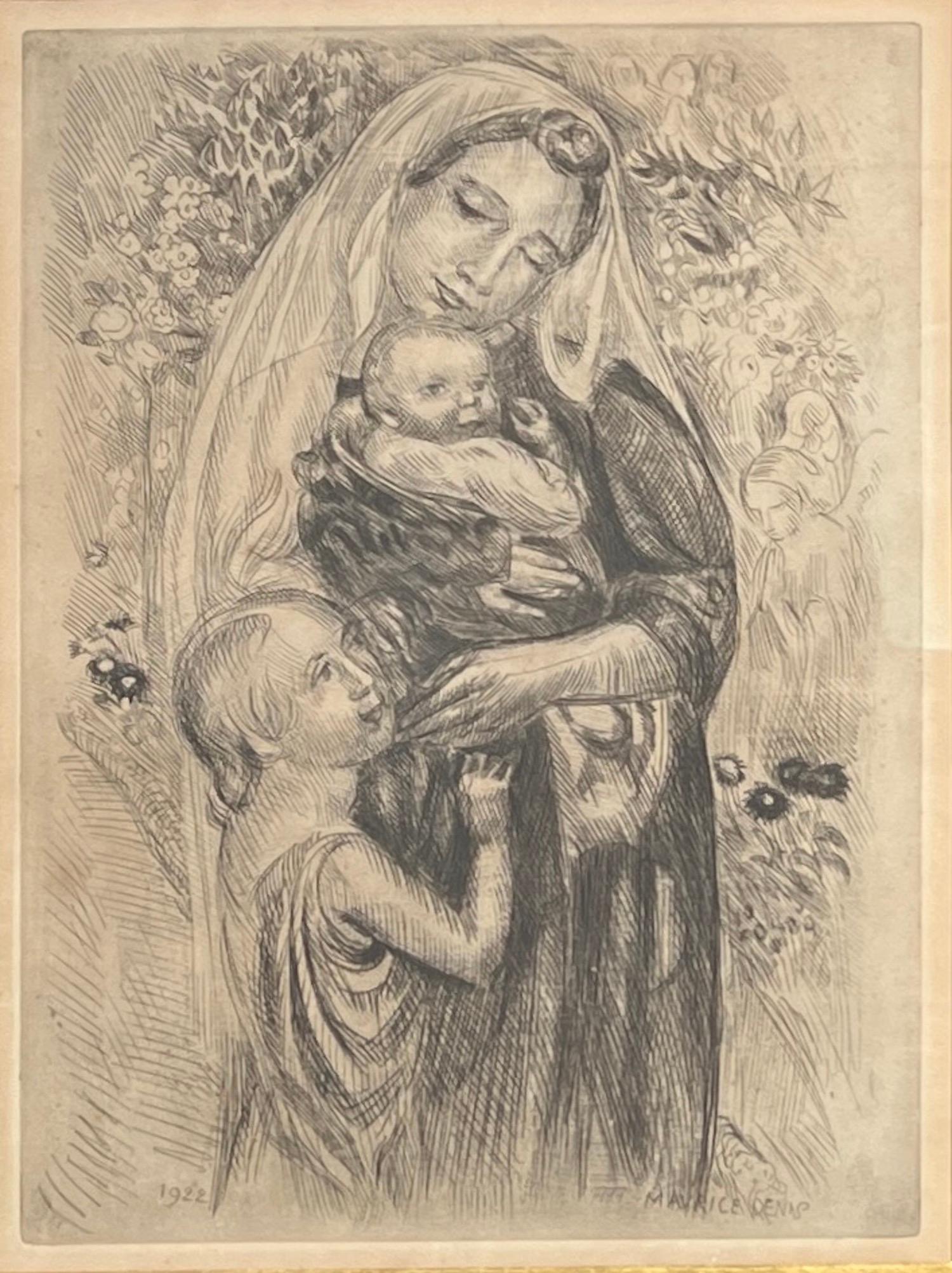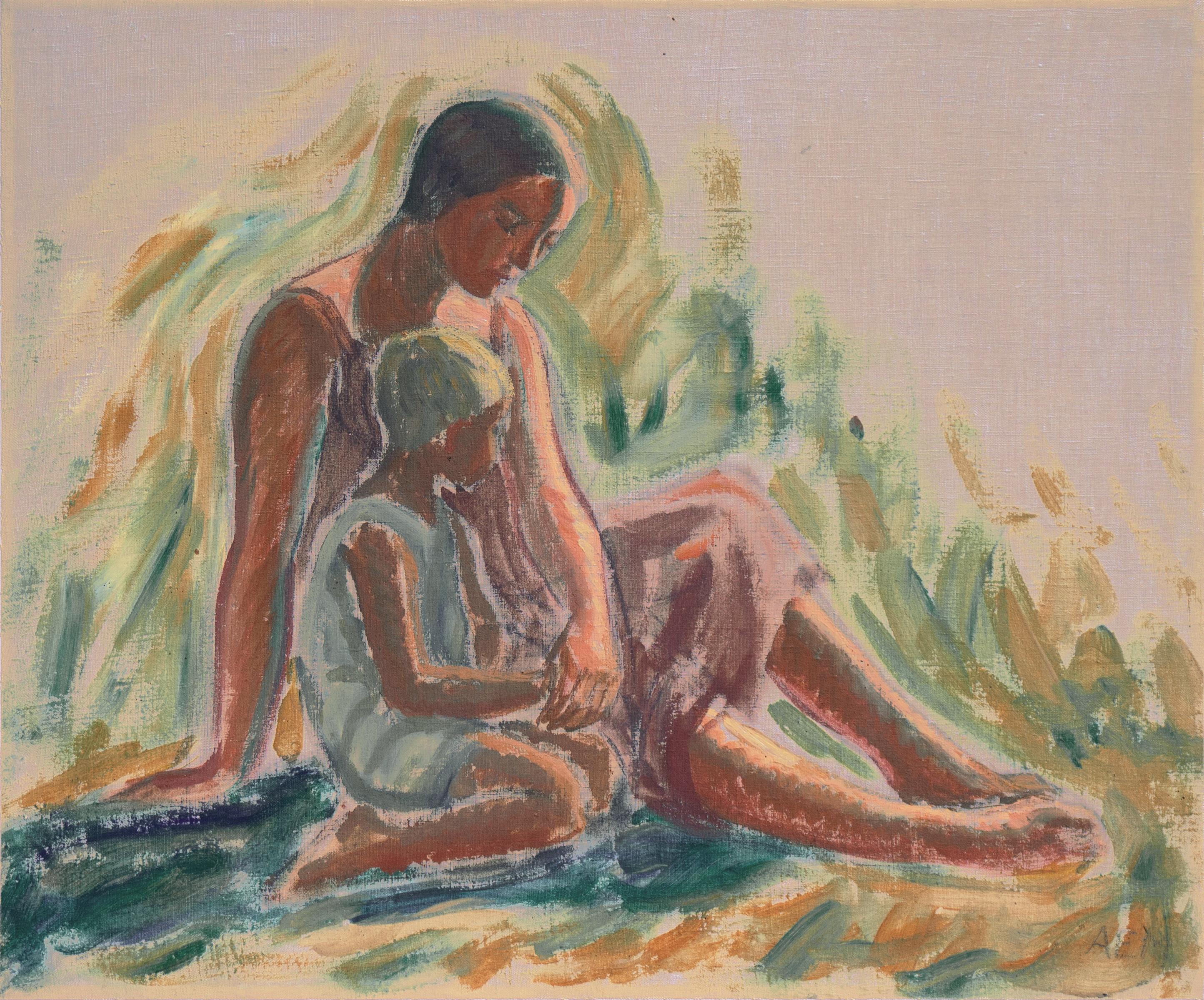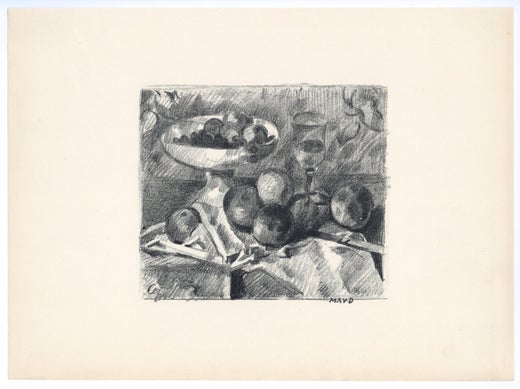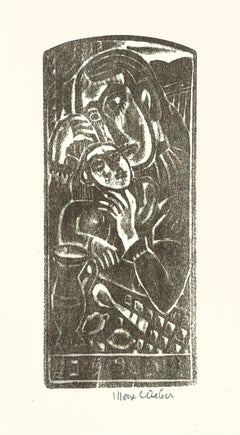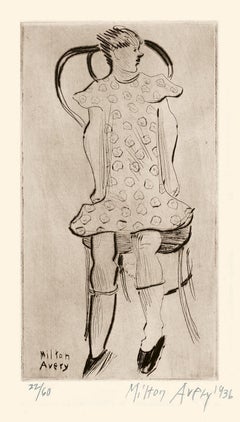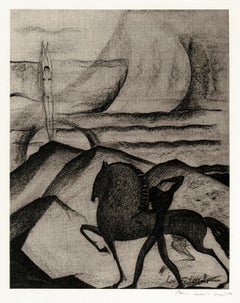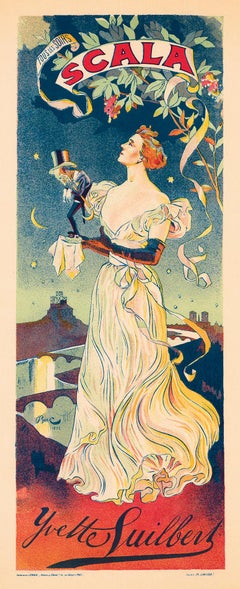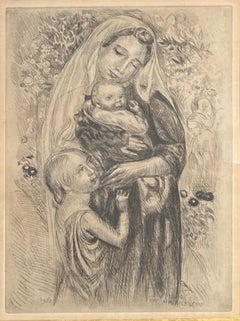Items Similar to Untitled (Mother and Child)
Want more images or videos?
Request additional images or videos from the seller
1 of 3
Maurice DenisUntitled (Mother and Child)1897
1897
$500
£387.36
€441.25
CA$715.87
A$781.78
CHF 410.37
MX$9,376.80
NOK 5,168.40
SEK 4,855.12
DKK 3,294.88
About the Item
Maurice Denis, Untitled (Mother and Child), lithograph, 1897, edition not stated. Signed in the stone, lower right. Annotated in linotype 'MAURICE DENIS, ORIGINAL LITHOGRAPHIE PAN III' in the lower left sheet corner. A fine, atmospheric impression, in warm, dark gray ink, on buff wove paper, with full margins (2 1/2 to 1 3/4 inches); a small discoloration in the bottom left sheet corner, otherwise in good condition. Image size 8 5/8 x 6 7/8 inches; sheet size 13 7/8 x 10 5/8 inches. As published in 'Pan', the leading German magazine of the period devoted to art and literature. Matted to museum standards, unframed.
Collection: Los Angeles County Museum of Art.
Reproduced: German Expressionist Prints and Drawings, The Robert Gore Rifkind Center for German Expressionist Studies, Los Angeles County Museum of Art, Prestel, 1989.
ABOUT THE ARTIST
Maurice Denis was a French painter, decorative artist, and writer, who was an important figure in the transitional period between impressionism and modern art. He was initially associated with 'Les Nabis', then the Symbolist movement, and later with a return to neo-classicism. See the online biography of Denis by John Kohan at: Sacred Art Pilgrim
- Creator:Maurice Denis (1870-1943, French)
- Creation Year:1897
- Dimensions:Height: 8.63 in (21.93 cm)Width: 6.88 in (17.48 cm)Depth: 0.01 in (0.26 mm)
- Medium:
- Movement & Style:
- Period:
- Condition:
- Gallery Location:Myrtle Beach, SC
- Reference Number:Seller: 1024961stDibs: LU53234351851
Maurice Denis
Painter, engraver and decorator, Maurice Denis. French artist, born in November 1870 in Granville in Normandy and died in November 1943. He studied at the Lycée Condorcet in Paris, then simultaneously at the École des beaux-arts and at the Académie Julien.
However, Denis did not recognize himself in the naturalist style promoted by his teachers, so he formed Les Nabis with other artists such as Paul Sérusier, Pierre Bonnard and Paul Elie Ranson. This group and artistic movement claims symbolism, partly inspired by Paul Gauguin and Émile Bernard. Denis and the Nabis have a characteristic style which consists of the application of large areas of paint and the use of radical and unusual colors. Denis is a very productive painter. He exhibited numerous works alongside those of other Symbolists and Neo-Impressionists during the 1890s. A characteristic work of this period is Spring (1897) which is now part of the permanent collection of the Met in New York. Throughout the first half of the 20th century, Denis exhibited his work regularly, both at the Salon de la Société Nationale and at the Salon des Indépendants. In 1914, he purchased and began the restoration of a 17th century priory in Saint-Germain-en-Laye near Paris. In 1980, the priory was transformed into a museum, dedicated to the works of Denis and more generally to the Nabi movement. The priory is renamed the Priory Departmental Museum. Denis' works have also been exhibited at the Montreal Museum of Fine Arts and the Walker Art Gallery in Liverpool, England.
About the Seller
5.0
Recognized Seller
These prestigious sellers are industry leaders and represent the highest echelon for item quality and design.
Platinum Seller
Premium sellers with a 4.7+ rating and 24-hour response times
Established in 1995
1stDibs seller since 2016
327 sales on 1stDibs
Typical response time: 1 hour
Associations
International Fine Print Dealers Association
- ShippingRetrieving quote...Shipping from: Myrtle Beach, SC
- Return Policy
Authenticity Guarantee
In the unlikely event there’s an issue with an item’s authenticity, contact us within 1 year for a full refund. DetailsMoney-Back Guarantee
If your item is not as described, is damaged in transit, or does not arrive, contact us within 7 days for a full refund. Details24-Hour Cancellation
You have a 24-hour grace period in which to reconsider your purchase, with no questions asked.Vetted Professional Sellers
Our world-class sellers must adhere to strict standards for service and quality, maintaining the integrity of our listings.Price-Match Guarantee
If you find that a seller listed the same item for a lower price elsewhere, we’ll match it.Trusted Global Delivery
Our best-in-class carrier network provides specialized shipping options worldwide, including custom delivery.More From This Seller
View AllMother Love (Madonna and Child) — American Expressionism
By Max Weber
Located in Myrtle Beach, SC
Max Weber, 'Mother Love' (Madonna and Child), woodcut, 1920, edition not stated, Rubenstein 35. Signed in pencil. A fine impression, on cream wove Japan paper, with full margins (1 5...
Category
1920s Expressionist Figurative Prints
Materials
Woodcut
'Little Girl' — American Modernism
By Milton Avery
Located in Myrtle Beach, SC
Milton Avery, 'Little Girl', drypoint, 1936, edition 60, Lunn 11. Signed, dated, and numbered '22/60' in pencil. A superb impression, in warm black ink with delicate overall plate tone, on off-white wove paper, with wide margins (2 5/8 to 4 1/8 inches); hinge stains on the top sheet edge, verso, otherwise in excellent condition. Matted to museum standards, unframed.
Image size 8 3/4 x 4 3/4 inches (222 x 121 mm); sheet size 14 7/8 x 13 1/8 inches (378 x 333 mm).
Collections: Cantor Arts Center, National Gallery of Art.
ABOUT THE ARTIST
"I never have any rules to follow; I follow myself."
"I paint not by sight but by faith. Faith gives you sight."
—Milton Avery
'His is the poetry of sheer loveliness.'
—Mark Rothko in his 1965 eulogy to Avery.
Milton Avery (1885-1965) is recognized as one of America's foremost modernist artists, renowned for his uniquely expressive style, evocative use of color, and captivating compositions.
Growing up in a working-class family in Altmar, New York, Avery's early life was marked by the struggles and realities of rural New York. Despite lacking formal artistic training, he displayed an innate talent for drawing from an early age. In 1905, his family relocated to Hartford, Connecticut, where he worked various odd jobs while developing his artistic skills through self-study and experimentation. In 1915, he enrolled at the Connecticut League of Art Students, where he received formal instruction and began to refine his distinctive style.
In 1918, Avery transferred to the School of the Art Society of Hartford and worked in the evenings so that he could paint during the day. He became a member of the Connecticut Academy of Fine Arts in 1924. That summer in Gloucester, Massachusetts, he met the artist Sally Michael...
Category
1930s American Modern Figurative Prints
Materials
Drypoint
Rendez-Vous — Early 20th-Century Modernism
By Boris Lovet-Lorski
Located in Myrtle Beach, SC
Boris Lovet-Lorski, Untitled (Rendez-Vous), lithograph, edition 250, 1929. Signed in pencil. Signed in the stone, lower right. From a suite of 10 lithographs published by the artist ...
Category
1920s American Modern Nude Prints
Materials
Lithograph
'Yvette Guilbert, SCALA' — Fin de Siècle, Paris
Located in Myrtle Beach, SC
BAC (Ferdinand Bach), 'Yvette Guilbert, Tous les Soirs SCALA', vintage color lithograph, 1893. Signed, dated, and titled in the stone.
A superb, richl...
Category
1890s Art Nouveau Figurative Prints
Materials
Lithograph
'Girl and Cat' — 1930s American Modernism
By Benton Murdoch Spruance
Located in Myrtle Beach, SC
'Girl and Cat', lithograph, 1935, edition 33, Fine and Looney 121. Signed, titled, dated, and numbered '5/33' in pencil. A superb, richly-inked impression...
Category
1930s American Modern Figurative Prints
Materials
Lithograph
'Erinnerung (Remembrance)' — Turn-of-the Century Romanticism
By Max Klinger
Located in Myrtle Beach, SC
Max Klinger, 'Erinnerung' (Remembrance), original etching with aquatint, 1896. A fine, richly inked impression on off-white, wove paper, with full margins (1 3/4 to 3 1/8 inches), in...
Category
1890s Post-Impressionist Figurative Prints
Materials
Etching, Aquatint
You May Also Like
Portrait of Mother and Daughter - Lithograph
By Maurice Denis
Located in Paris, IDF
Maurice DENIS (1870 - 1943)
The Woman in the Green Coat, 1918
Lithograph
On vellum 47 x 36,5 cm (c. 18,5 x 14,3 inch)
INFORMATION : Edited by Louis Rouart in Paris, from a drawing ...
Category
Early 20th Century Academic Figurative Prints
Materials
Lithograph
Madonna, children and cherub
By Maurice Denis
Located in Genève, GE
Work on paper
Wooden frame with glass pane
57 x 46.5 x 2.5 cm
Category
1920s French School Figurative Prints
Materials
Etching
Maternity : Original lithograph, 1927
By Maurice Denis
Located in Paris, IDF
Maurice DENIS
Maternity
Original stone lithograph
Signed with the stamp of the artist
From a limited edition of 35 proofs (not numbered)
On Japan paper 50 x 32.5 cm (c. 20 x 13 inch...
Category
1920s Modern Figurative Prints
Materials
Lithograph
Maternity : Mother and Child - Etching
By Mary Cassatt
Located in Paris, IDF
Mary Cassatt (1844-1926)
Maternal Love
Engraving after a pastel
Signed in the plate
On vellum, 50 x 38 cm (c. 20 x 15 in)
INFORMATION: Copperplate engraving published by the Galer...
Category
Early 20th Century Post-Impressionist Figurative Prints
Materials
Etching, Aquatint
'Mother and Child', Woman Impressionist, Paris, Académie Julian, Benezit
Located in Santa Cruz, CA
Initialed lower right, 'A.E.M' for Anna Elisabeth Munch (Danish, 1876-1960) and painted circa 1940.
This notable Danish Modernist first studied with Karl Jensen (1889) and C. N. Overgaard (1891–1892). She later traveled and studied in Italy and, subsequently, at the Académie Julian under Jean Paul Laurens and Benjamin Constant. After her return to Denmark, Munch became a student of the Impressionist Julius Paulsen (1895-1897) and made her début at the 1898 Charlottenborg Spring Exhibition.
Munch became the first Danish woman to receive commissions for large devotional altarpieces and her early subjects were often derived from Nordic and Christian mythology. These themes were also explored in the large fresco commissions she completed after studying fresco with Joakim Skovgaard (1909-10).
Munch continued her studies in both France and Italy and also traveled extensively to Sweden and Norway. Together with the writer Sophie Breum, Munch built a house on the island of Funen at the artist's colony of Kerteminde. Munch illustrated several of Breum's books and, through her, was introduced to the women's movement. She furthered her art studies with Fritz Syberg...
Category
1940s Post-Impressionist Figurative Paintings
Materials
Canvas, Oil
The Communicants - Original lithograph
By Maurice Denis
Located in Paris, IDF
Maurice DENIS (1870 - 1943)
The Communicants
Original lithograph with charcoal enhancement
Printed signature in the plate
On light vellum 48 x 28 cm (c. 19 x 11 inch)
Excellent con...
Category
Early 20th Century Realist Figurative Prints
Materials
Lithograph
$353 Sale Price
40% Off
More Ways To Browse
Dali Signed Dante
Dali Tapestry
Dali The Kiss
Dali Tree Of Life
Dali Tree Of Penitence
Dali Trilogy
Dali Turtle
Dali Venus In Furs
Dali Virgil Last Words
Damien Hirst The Dead
David Dawson
David Hockney Blue Guitar
David Hockney Lemon
David L Abel
David Shrigley Black Cats Everywhere
Degas Ballerina Etchings
Degas Signed Lithograph
Dieu Et Mon Droit
